Prediction of Maritime Pine Boards Modulus of Elasticity by Means of Sonic Testing on Green Timber
Abstract
:1. Introduction
2. Materials
3. Methods
3.1. Measurement of Moisture Content
3.2. Measurement of Sonic Velocity
3.2.1. Theoretical
3.2.2. Experimental
- an impact hammer with piezoceramic sensor for generating the signal,
- a piezoelectric transducer for receiving the signal,
- a Velleman Instruments digital oscilloscope for signal visualization and preliminary analysis, and
- a PC for data storage and signal processing.
4. Results and Discussion
5. Conclusions
- In the passage from the wet to the dry state, mass and density undergo an average reduction of 23%, whereas sonic velocity and MoEdyn show an increase of about 18% and 8%, respectively.
- The inverse dependence of MoEdyn with respect to density and sonic velocity and the greater weight of velocity in the variation of MoEdyn from wet to dry state are highlighted.
- The linear regression analysis for predicting MoEdry from MoEwet points out the good level of correlation between the two parameters, being the determination coefficient R2 about 0.8, and allows to implement a relationship to estimate MoEdyn in the dry condition starting from MoEdyn measured in wet condition.
- A two-variable regression model, assuming ρwet and Vwet as predictive parameters and MoEdry as the predicted feature, gives a determination coefficient R2 of about 0.76, and allows to implement a straightforward relationship to estimate MoEdyn in the dry condition starting from density and propagation velocity measured directly on wet boards, bypassing MoEdyn computing in the wet condition.
Funding
Institutional Review Board Statement
Informed Consent Statement
Data Availability Statement
Conflicts of Interest
References
- Asdrubali, F.; Ferracuti, B.; Lombardi, L.; Guattari, C.; Evangelisti, L.; Grazieschi, G. A review of structural, thermo-physical, acoustical, and environmental properties of wooden materials for building applications. Build. Environ. 2017, 114, 307–332. [Google Scholar] [CrossRef]
- Suter, F.; Steubing, B.; Hellweg, S. Life Cycle Impacts and Benefits of Wood along the Value Chain: The Case of Switzerland. J. Ind. Ecol. 2016, 21, 874–886. [Google Scholar] [CrossRef] [Green Version]
- Stocchero, A.; Seadon, J.K.; Falshaw, R.; Edwards, M. Urban Equilibrium for sustainable cities and the contribution of timber buildings to balance urban carbon emissions: A New Zealand case study. J. Clean. Prod. 2017, 143, 1001–1010. [Google Scholar] [CrossRef]
- Börjesson, P.; Gustavsson, L. Greenhouse gas balances in building construction: Wood versus concrete from life-cycle and forest land-use perspectives. Energy Policy 2000, 28, 575–588. [Google Scholar] [CrossRef]
- Gustavsson, L.; Sathre, R. Variability in energy and carbon dioxide balances of wood and concrete building materials. Build. Environ. 2006, 41, 940–951. [Google Scholar] [CrossRef]
- Hafner, A.; Schafer, S. Comparative LCA study of different timber and mineral buildings and calculation method for substitution factors on building level. J. Clean. Prod. 2017, 167, 630–642. [Google Scholar] [CrossRef]
- Lu, H.R.; El Hanandeh, A.; Gilbert, B.P. A comparative life cycle study of alternative materials for Australian multi-storey apartment building frame constructions: Environmental and economic perspective. J. Clean. Prod. 2017, 166, 458–473. [Google Scholar] [CrossRef]
- Gerilla, G.P.; Teknomo, K.; Hokao, K. An environmental assessment of wood and steel reinforced concrete housing construction. Build. Environ. 2007, 42, 2778–2784. [Google Scholar] [CrossRef]
- Hill, C.A.S.; Dibdiakova, J. The environmental impact of wood compared to other building materials. Int. Wood Prod. J. 2016, 7, 215–219. [Google Scholar] [CrossRef]
- Hassan, O.A.; Johansson, C. Glued laminated timber and steel beams. J. Eng. Des. Technol. 2018, 16, 398–417. [Google Scholar] [CrossRef]
- Anejo, J.A. Impact of Concrete, Steel and Timber on the Environment: A Review. Int. J. Technol. Enhanc. Emerg. Eng. Res. 2014, 2, 58–63. [Google Scholar]
- Ede, A.N.; Adebayo, S.O.; Ugwu, E.I.; Emenike, C. Life Cycle Assessment of Environmental Impacts of Using Concrete or Timber to Construct a Duplex Residential Building. IOSR J. Mech. Civil Eng. 2014, 11, 62–72. [Google Scholar] [CrossRef]
- Liu, Y.; Guo, H.; Sun, C.; Chang, W.S. Assessing Cross Laminated Timber (CLT) as an Alternative Material for Mid-Rise Residential Buildings in Cold Regions in China—A Life-Cycle Assessment Approach. Sustainability 2016, 8, 1047. [Google Scholar] [CrossRef] [Green Version]
- Sandanayake, M.; Lokuge, W.; Zhang, G.; Setunge, S.; Thushar, Q. Greenhouse gas emissions during timber and concrete building construction—A scenario based comparative case study. Sustain. Cities Soc. 2018, 38, 91–97. [Google Scholar] [CrossRef] [Green Version]
- Skullestad, J.L.; Bohne, R.A.; Lohne, J. High-rise Timber Buildings as a Climate Change Mitigation Measure—A Comparative LCA of Structural System Alternatives. Energy Procedia 2016, 96, 112–123. [Google Scholar] [CrossRef] [Green Version]
- EN 14081-1:2016+A1:2019 Timber Structures—Strength Graded Structural Timber with Rectangular Cross Section, Part 1: General Requirements.
- EN 14081-2:2018 Timber Structures—Strength Graded Structural Timber with Rectangular Cross Section, Part 2: Machine Grading; Additional Requirements for Type Testing.
- EN 14081-3:2012+A1:2018 Timber Structures—Strength Graded Structural Timber with Rectangular Cross Section, Part 3: Machine grading; Additional Requirements for Factory Production Control.
- Puettmann, M.E.; Wilson, J.B. Gate-to-gate life-cycle inventory of glued laminated timbers production. Wood Fiber Sci. 2005, 37, 99–113. [Google Scholar]
- Puettmann, M.E.; Oneil, E.; Johnson, L. Cradle to Gate Life Cycle Assessment of Softwood Plywood from the Pacific Northwest Technical Report; Consortium for Research on Renewable Industrial Materials: Seattle, WA, USA, 2013. [Google Scholar]
- Bergman, R.; Bowe, S.A. Impact of producing hardwoods using life-cycle inventory. Wood Fiber Sci. 2008, 40, 448–458. [Google Scholar]
- Adhikari, S.; Ozarska, B. Minimizing environmental impacts of timber products through the production process “From Sawmill to Final Products”. Environ. Syst. Res. 2018, 7, 6. [Google Scholar] [CrossRef]
- Bond, B.H.; Espinoza, O. A Decade of Improved Lumber Drying Technology. Curr. For. Rep. 2016, 2, 106–118. [Google Scholar] [CrossRef]
- Ridley-Ellis, D.; Stapel, P.; Baño, V. Strength grading of sawn timber in Europe: An explanation for engineers and researchers. Holz als Roh- und Werkst. 2016, 74, 291–306. [Google Scholar] [CrossRef]
- McDonald, K.A.; Green, D.W.; Schad, K.C. Relationship between log and lumber modulus of elasticity. Forest Prod. J. 1997, 47, 89–92. [Google Scholar]
- Carter, P.; Chauhan, S.; Walker, J. Sorting logs and lumber for stiffness using Director HM200. Wood Fiber Sci. 2007, 38, 49–54. [Google Scholar]
- Rais, A.; Pretzsch, H.; Van De Kuilen, J.-W.G. Roundwood pre-grading with longitudinal acoustic waves for production of structural boards. Eur. J. Wood Wood Prod. 2014, 72, 87–98. [Google Scholar] [CrossRef]
- Unterwieser, H.; Schickhofer, G. Influence of moisture content of wood on sound velocity and dynamic MOE of natural frequency- and ultrasonic runtime measurement. Eur. J. Wood Prod. 2011, 69, 171–181. [Google Scholar] [CrossRef] [Green Version]
- Unterwieser, H.; Schickhofer, G. Pre-grading of sawn timber in green condition. In Proceedings of the COST E 53 Conference-Quality Control for Wood and Wood Products, Warsaw, Poland, 15–17 October 2007. [Google Scholar]
- Baillères, H.; Hopewell, G.; Boughton, G.; Brancheriau, L. Strength and Stiffness Assessment Technologies for Improving Grading Effectiveness of Radiata Pine Wood. BioResources 2012, 7, 1264–1282. [Google Scholar]
- Brashaw, B.K.; Wang, X.; Ross, R.J.; Pellerin, R.F. Relationship between stress wave velocities of green and dry veneer. For. Prod. J. 2004, 54, 85–89. [Google Scholar]
- Halabe, U.B.; Bidigalu, G.M.; GangaRao, H.V.S.; Ross, R.J. Nondestructive Evaluation of Green Dimension Lumber Using Stress Wave and Transverse Vibration Techniques. In Review of Progress in Quantitative Nondestructive Evaluation; Thompson, D.O., Chimenti, D.E., Eds.; Springer: Boston, MA, USA, 1996. [Google Scholar] [CrossRef] [Green Version]
- Montero, M.; De La Mata, J.; Hermoso, E.; Esteban, M. Influence of moisture content on the wave velocity to estimate the mechanical properties of large cross-section pieces for structural use of Scots pine from Spain. Maderas. Cienc. Tecnol. 2015, 17, 407–420. [Google Scholar] [CrossRef] [Green Version]
- Nocetti, M.; Brunetti, M.; Bacher, M. Effect of moisture content on the flexural properties and dynamic modulus of elasticity of dimension chestnut timber. Eur. J. Wood Prod. 2015, 73, 51–60. [Google Scholar] [CrossRef]
- Nocetti, M.; Pröller, M.; Brunetti, M.; Dowse, G.P.; Wessels, C.B. Investigating the Potential of Strength Grading Green Eucalyptus grandis Lumber using Multi-Sensor Technology. BioResources 2017, 12, 9273–9286. [Google Scholar]
- Wang, X. Stress Wave E-Rating of Structural Timber—Size and Moisture Content Effects, Proceedings of the 18th International Nondestructive Testing and Evaluation of Wood Symposium; General Technical Report FPL-GTR-226, Madison, WI, USA, 24–27 September 2013; Department of Agriculture, Forest Service, Forest Products Laboratory: Washington, DC, USA, 2013; pp. 38–46. [Google Scholar]
- Nocetti, M.; Brunetti, M.; Bacher, M. Efficiency of the machine grading of chestnut structural timber: Prediction of strength classes by dry and wet measurements. Mater. Struct. 2016, 49, 4439–4450. [Google Scholar] [CrossRef]
- Pommier, R.; Breysse, D.; Dumail, J.-F. Non-destructive grading of green Maritime pine using the vibration method. Eur. J. Wood Prod. 2013, 71, 663–673. [Google Scholar] [CrossRef]
- Fortino, S.; Metsäjoki, J.; Ronkainen, H.; Bjurhager, I.; Heinemann, S.; Salminen, L.I. Scratch resistance of PEG impregnated green wood: A method for evaluation of swollen wood properties. Wood Sci. Technol. 2020, 54, 715–735. [Google Scholar] [CrossRef]
- Riu, R. Caratterizzazione di Pannelli XLam in Pino Marittimo Sardo. Ph.D. Thesis, University of Cagliari, Cagliari, Sardinia, Italy, 2016. [Google Scholar]
- Concu, G.; De Nicolo, B.; Fragiacomo, M.; Trulli, N.; Valdes, M. Grading of maritime pine from Sardinia (Italy) for use in cross-laminated timber. Proc. Inst. Civ. Eng. Constr. Mater. 2018, 171, 11–21. [Google Scholar] [CrossRef]
- Trulli, N.; Valdés, M.; De Nicolo, B.; Fragiacomo, M.; Trulli, N. Grading of Low-Quality Wood for Use in Structural Elements. Wood Civil Eng. 2017. Available online: https://www.intechopen.com/books/wood-in-civil-engineering/grading-of-low-quality-wood-for-use-in-structural-elements (accessed on 15 February 2021). [CrossRef] [Green Version]
- SardegnaForeste. Available online: https://www.sardegnaforeste.it/flora/pino-marittimo#:~:text=Il%20pino%20marittimo%20%C3%A8%20una,e%20del%20pino%20d’Aleppo (accessed on 13 January 2021).
- EN 1912:2012 Structural Timber—Strength Classes; Assignment of Visual Grades and Species.
- Concu, G.; De Nicolo, B.; Trulli, N.; Valdés, M.; Fragiacomo, M. Strength class prediction of Sardinia grown timber by means of non-destructive parameters. Adv. Mater. Res. 2013, 778, 191–198. [Google Scholar] [CrossRef]
- Concu, G.; De Nicolo, B.; Trulli, N.; Valdés, M.; Fragiacomo, M. Sonic testing on cross laminated timber panels. In Proceedings of the SEMC 2016: The 6th International Conference on Structural Engineering, Mechanics and Computation—Insights and Innovations in Structural Engineering, Mechanics and Computation, Cape Town, South Africa, 5–7 September 2016; e-book. ISBN 978-1-315-64164-5. [Google Scholar]
- Concu, G.; Fragiacomo, M.; Trulli, N.; Valdès, M. Non-destructive assessment of gluing in cross-laminated timber panels, WIT Transactions on Ecology and The Environment. Sustain. Dev. Plan. IX 2017, 226, 559–569. [Google Scholar] [CrossRef] [Green Version]
- Meloni, D.; Concu, G.; Valdes, M.; Giaccu, F. FEM models for elastic parameters identifications of cross laminated maritime pine panels. In Proceedings of the WCTE 2018-World Conference on Timber Engineering, Seoul, Korea, 20–23 August 2018. [Google Scholar]
- Giaccu, G.F.; Meloni, D.; Concu, G.; Valdes, M. Consideration on dynamic identification of wood composite panels using a cantilever vibration method. In Proceedings of the WCTE 2018-World Conference on Timber Engineering, Seoul, Korea, 20–23 August 2018. [Google Scholar]
- Giaccu, G.F.; Meloni, D.; Concu, G.; Valdes, M.; Fragiacomo, M. Use of the cantilever beam vibration method for determining the elastic properties of maritime pine cross-laminated panels. Eng. Struct. 2019, 200, 109623. [Google Scholar] [CrossRef]
- Valdes, M.; Giaccu, G.F.; Meloni, D.; Concu, G. Reinforcement of maritime pine cross-laminated timber panels by means of natural flax fibers. Constr. Build. Mater. 2020, 233, 117741. [Google Scholar] [CrossRef]
- De Oliveira, F.G.R.; Candian, M.; Lucchette, F.F.; Salgon, J.L.; Sales, A. Moisture content effect on ultrasonic velocity in Goupia glabra. Mater. Res. 2005, 8, 11–14. [Google Scholar] [CrossRef]
- Bucur, V. Acoustics of Wood, 2nd ed.; Springer Series in Wood Science: Berlin/Heidelberg, Germany, 2006. [Google Scholar]
- Autengruber, M.; Lukacevic, M.; Füssl, J. Finite-element-based moisture transport model for wood including free water above the fiber saturation point. Int. J. Heat Mass Transf. 2020, 161, 120228. [Google Scholar] [CrossRef]
- EN 13183-2. Moisture Content of a Piece of Sawn Timber, Part 2: Estimation by Electrical Resistance Method.
- Cartz, L. Nondestructive Testing; ASM International: Almere, The Netherlands, 1995; p. 229. ISBN 978-0-87170-517-4. [Google Scholar]
- Rose, J.L. Ultrasonic Waves in Solid Media; Cambridge University Press: Cambridge, UK, 2004; p. 454. [Google Scholar]
- Legg, M.; Bradley, S. Measurement of stiffness of standing trees and felled logs using acoustics: A review. J. Acoust. Soc. Am. 2016, 139, 588–604. [Google Scholar] [CrossRef] [PubMed] [Green Version]
- Harris, P.; Andrews, M. Tools and acoustic techniques for measuring wood stiffness. In Proceedings of the 3rd Wood Quality Symposium: Emerging Technologies for Evaluating Wood Quality for Wood Processing, Forest Research, Rotorua, New Zealand, 30 November 1999; p. 11. [Google Scholar]
- Feeney, F.; Chivers, R.; Evertsen, J.; Keating, J. The Influence of Inhomogeneity on the Propagation of Ultrasound in Wood, Proceedings of the 10th International Symposium on Nondestructive Testing of Wood, Lausanne, Switzerland, 26–28 August 1996; Sandoz, J.L., Ed.; Presses Polytechniques et Universitaires Romandes: Lausanne, Switzerland, 1996; pp. 73–82. [Google Scholar]
- Simpson, W.T.; Wang, X. Relationship between longitudinal stress wave transit time and moisture content of lumber during kiln drying. For. Prod. J. 2001, 51, 51–54. [Google Scholar]
- Kang, H.; Booker, R.E. Variation of stress wave velocity with MC and temperature. Wood Sci. Technol. 2002, 36, 41–54. [Google Scholar] [CrossRef]
- Gonçalves, R.; Da Costa, O.A.L. Influence of moisture content on longitudinal, radial, and tangential ultrasonic velocity for two Brazilian wood species. Wood Fiber Sci. 2008, 40, 580–586. [Google Scholar]

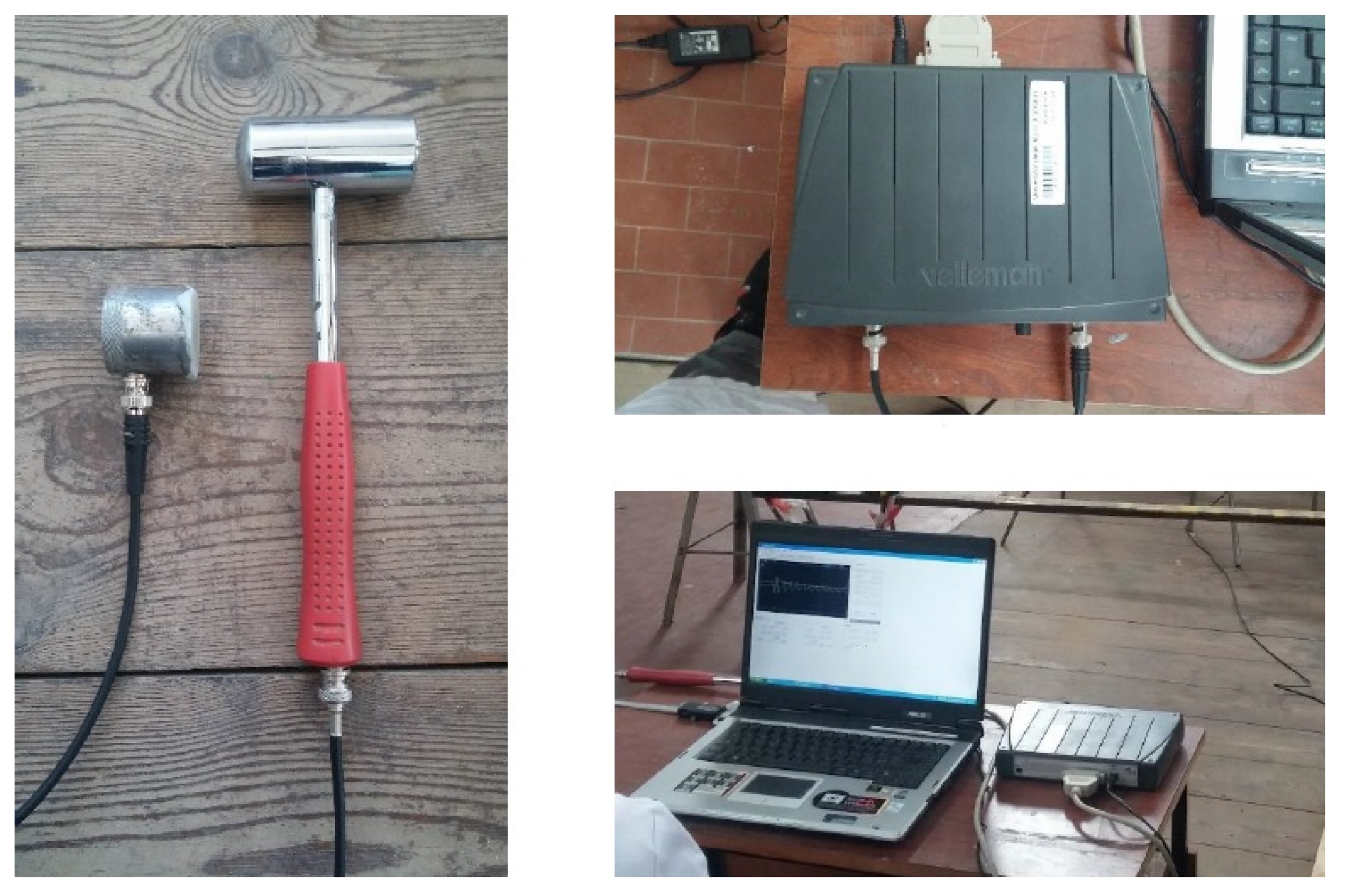
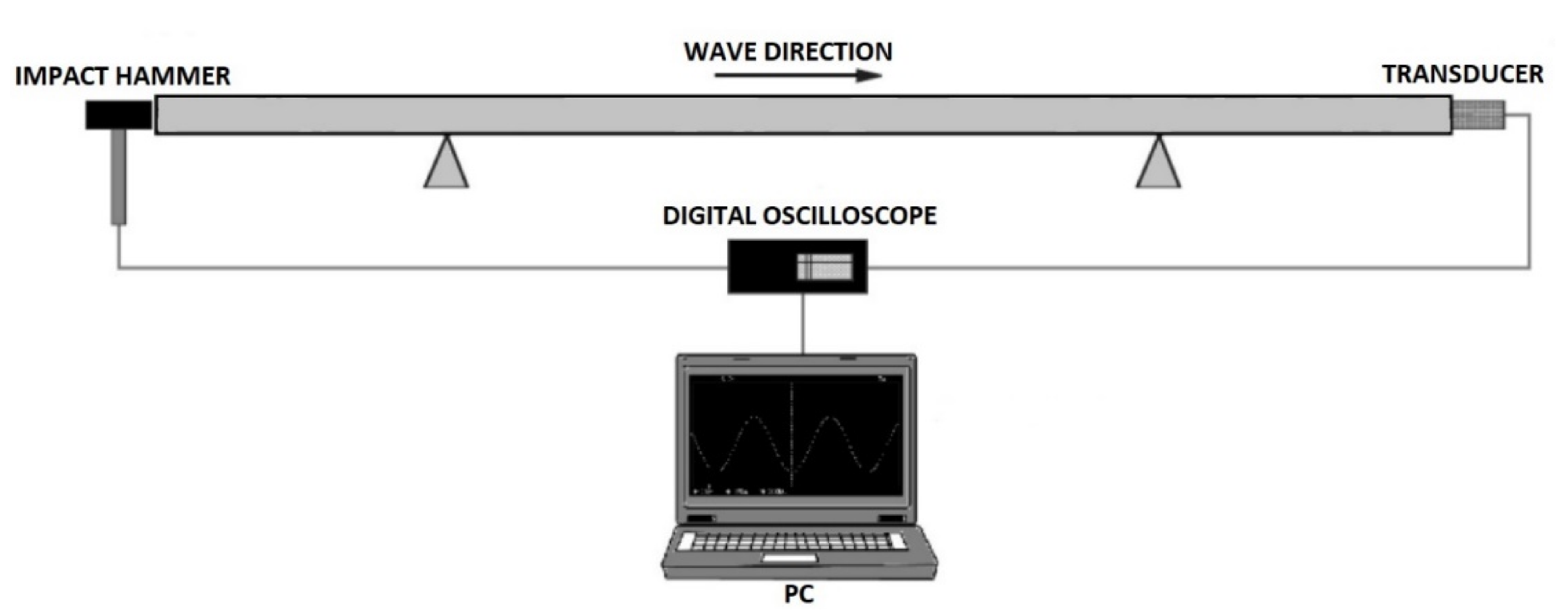
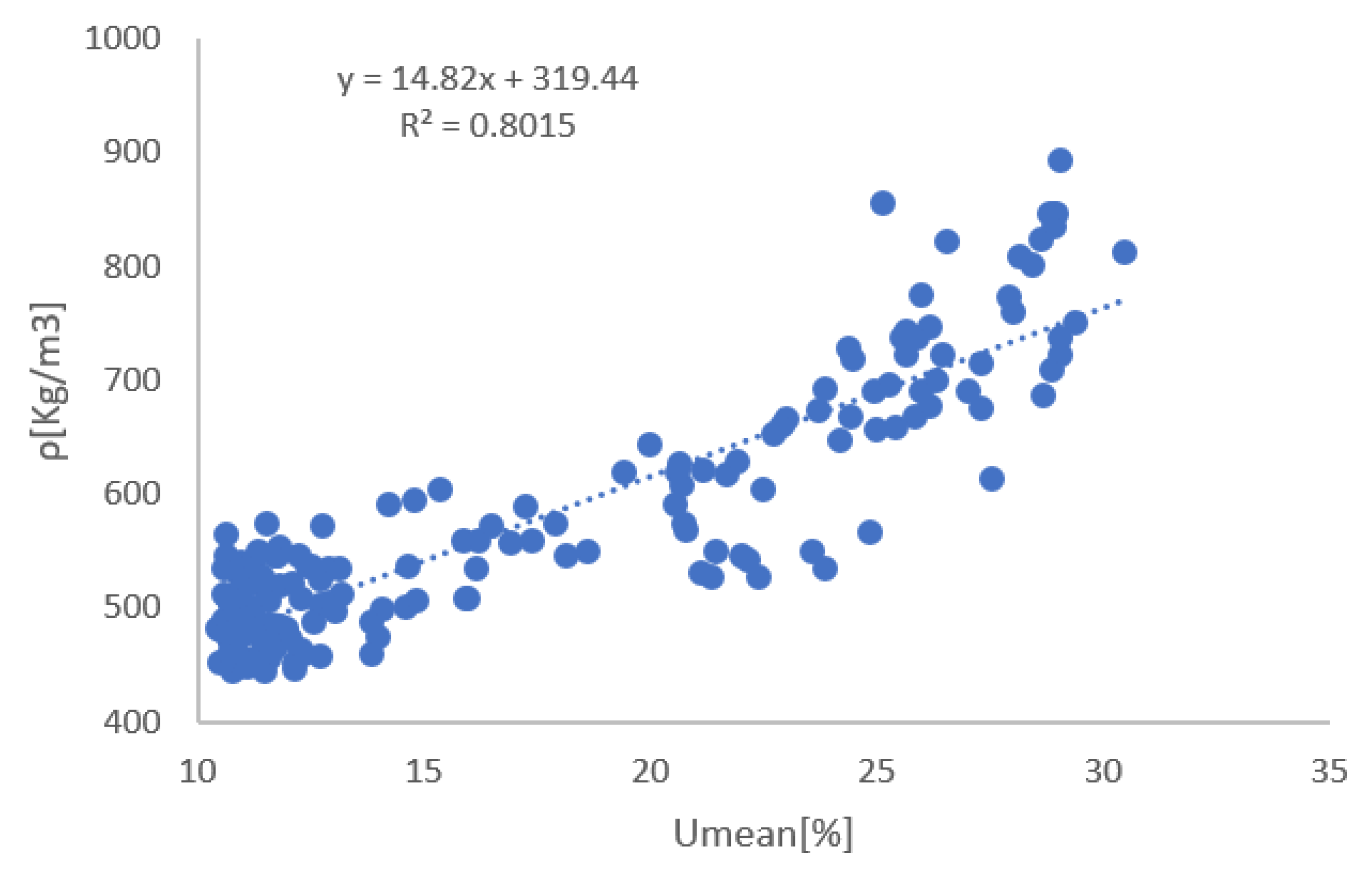
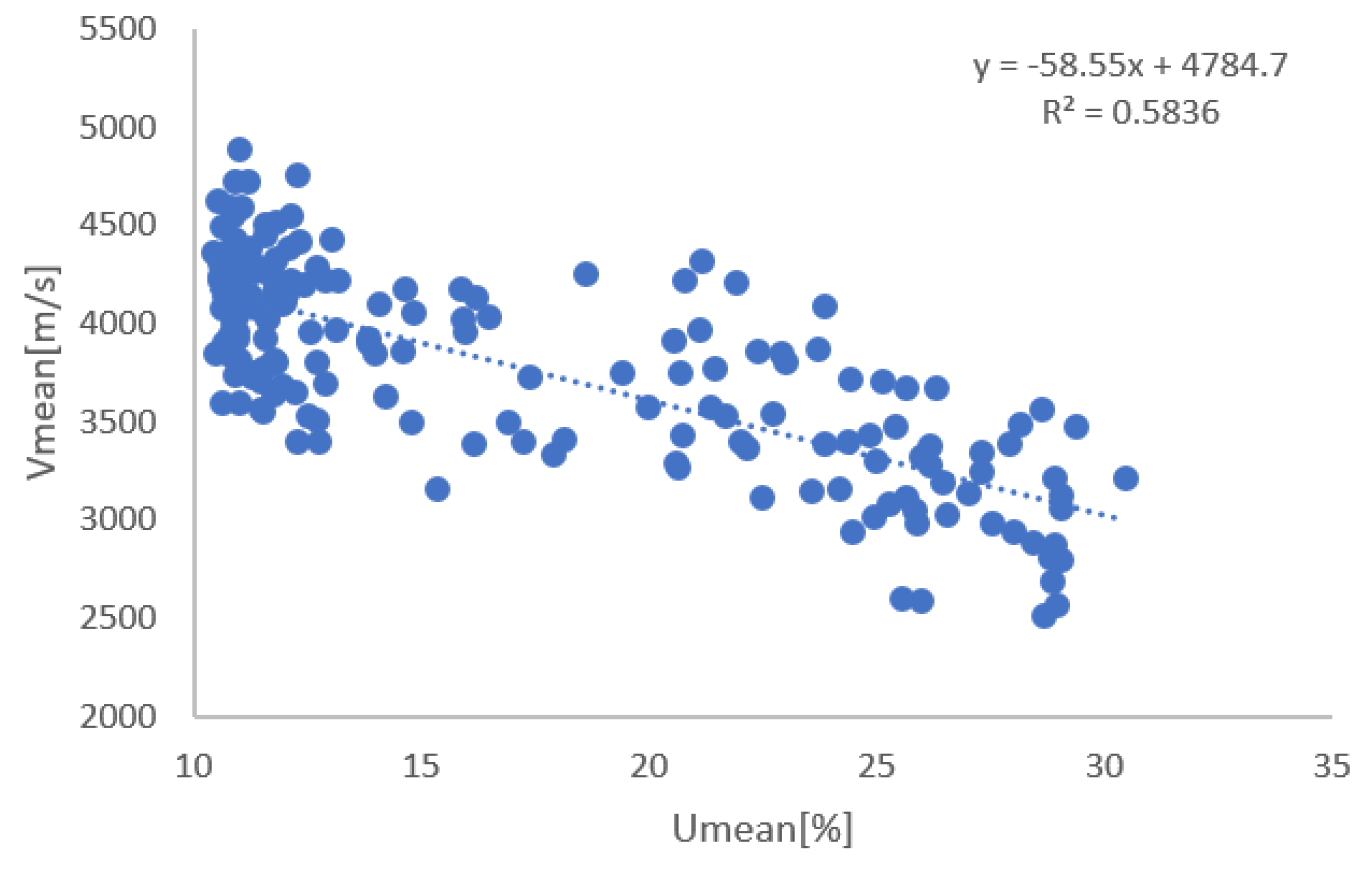
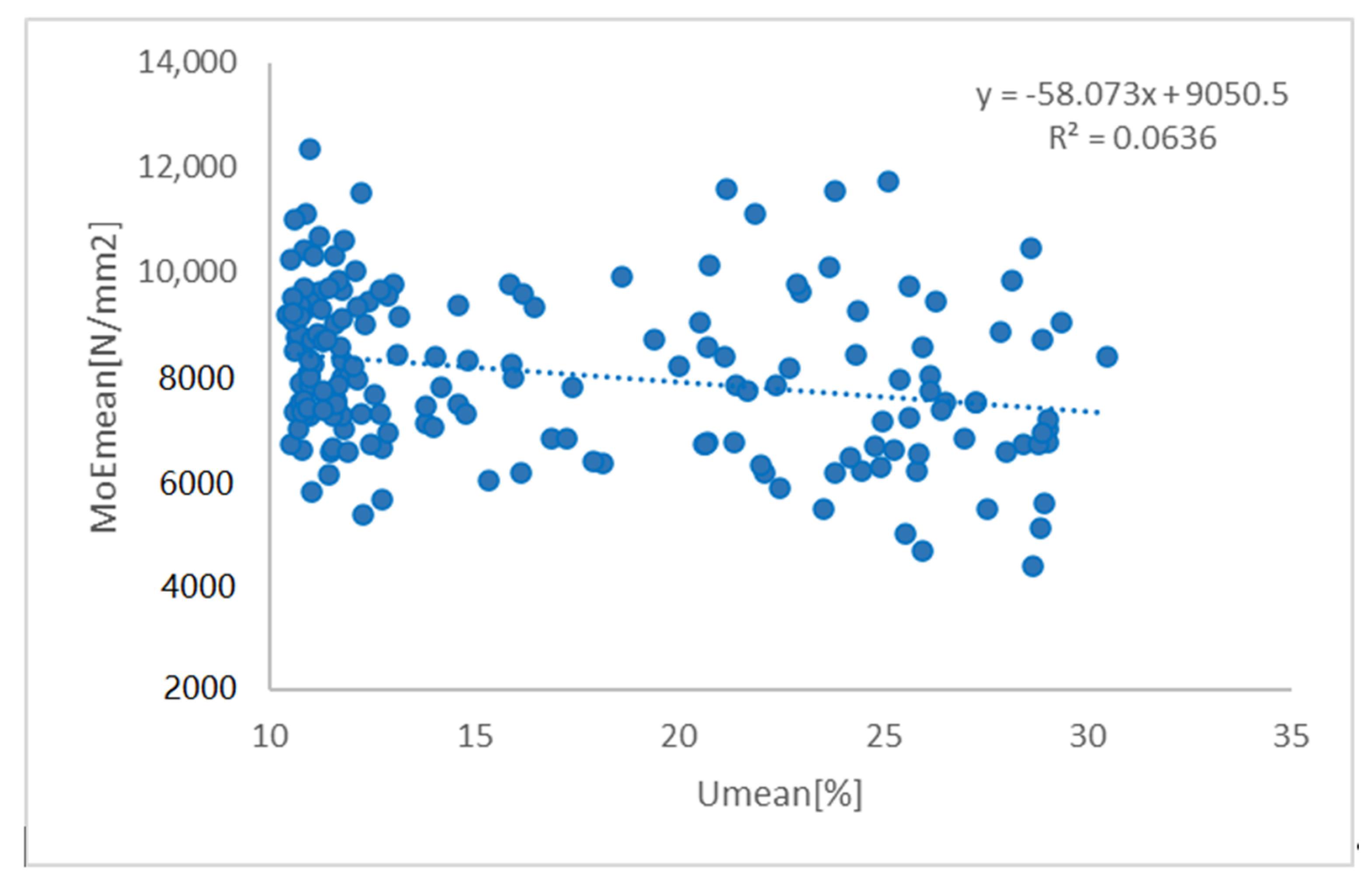


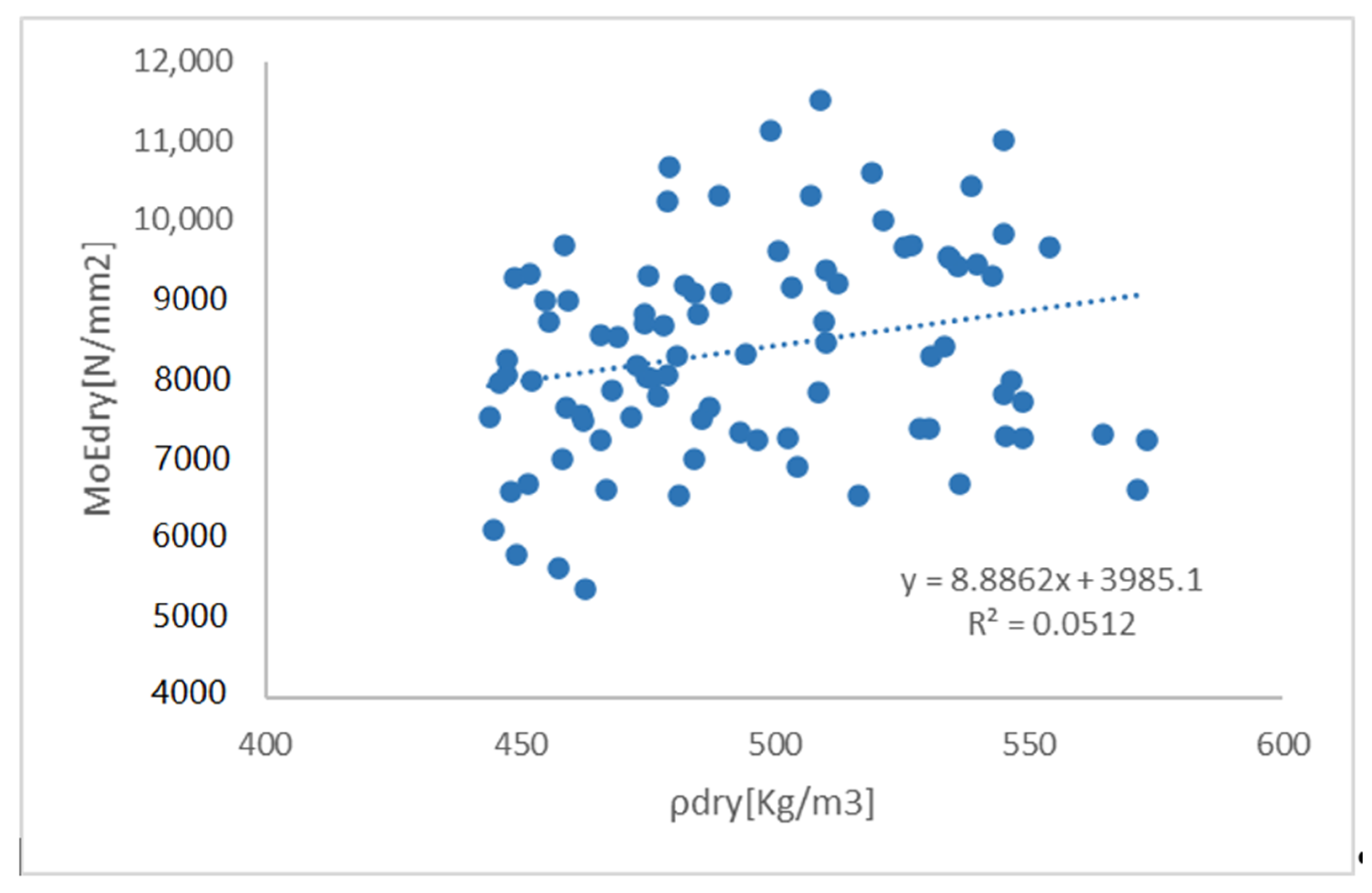
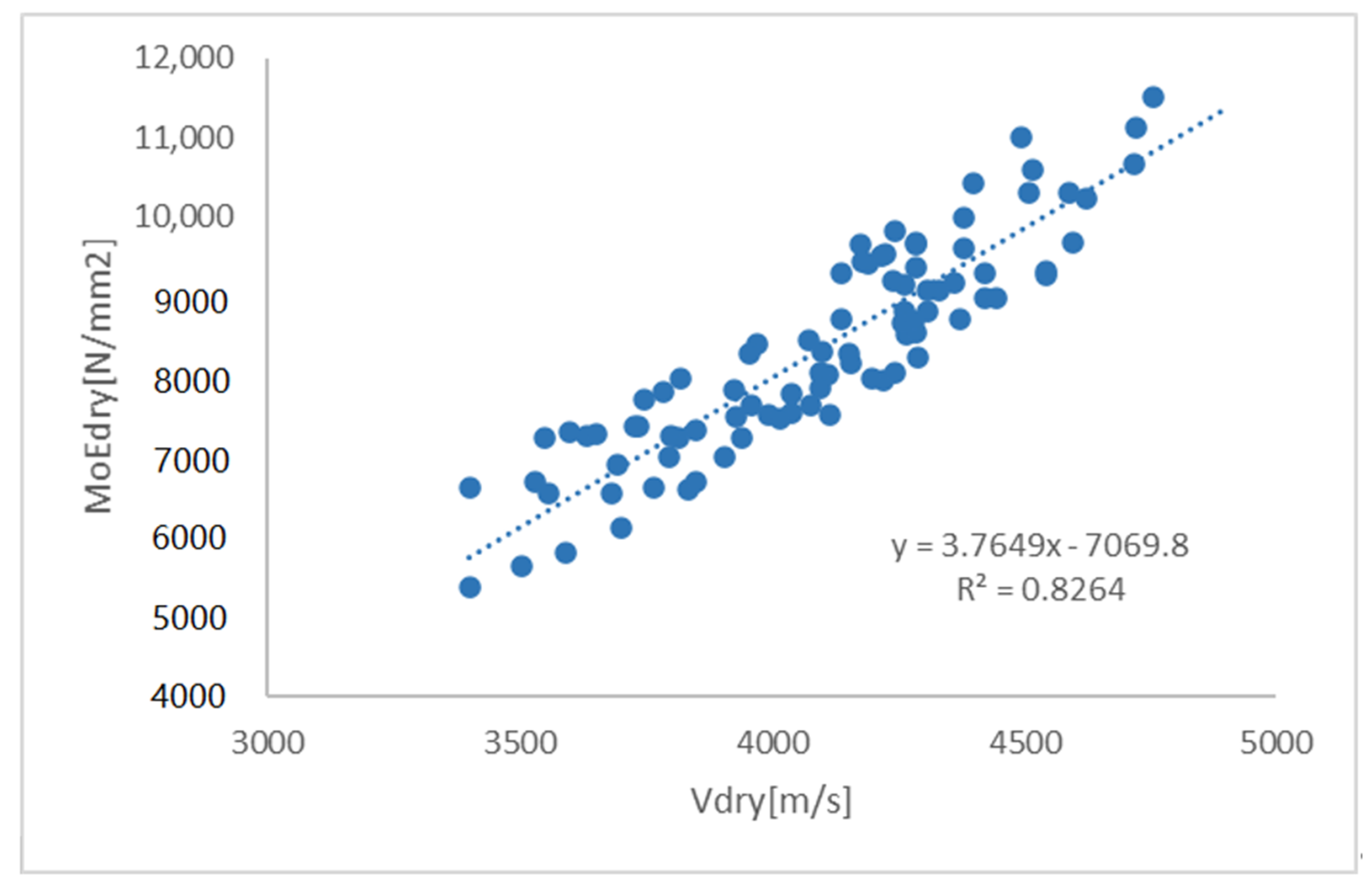
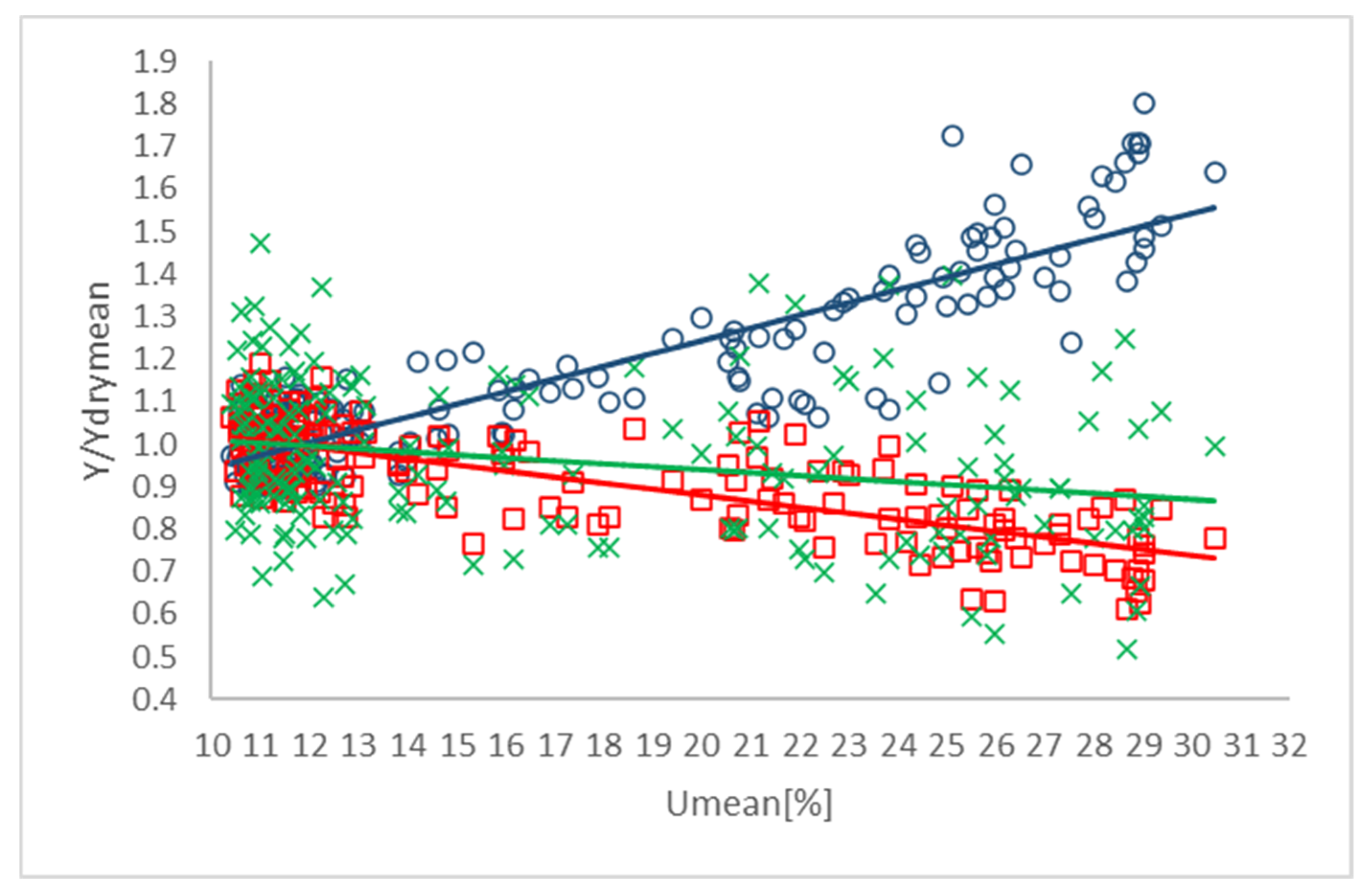
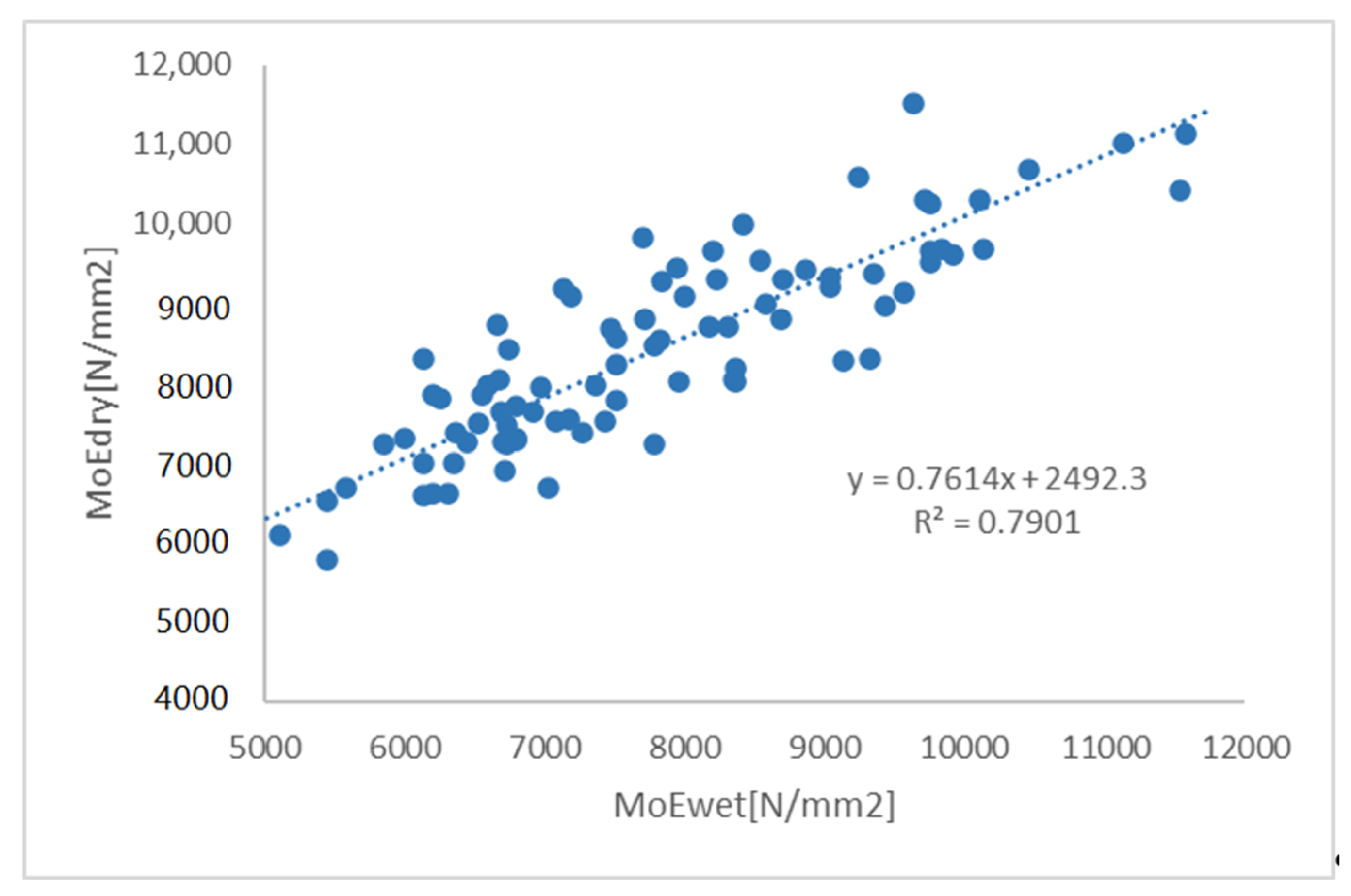
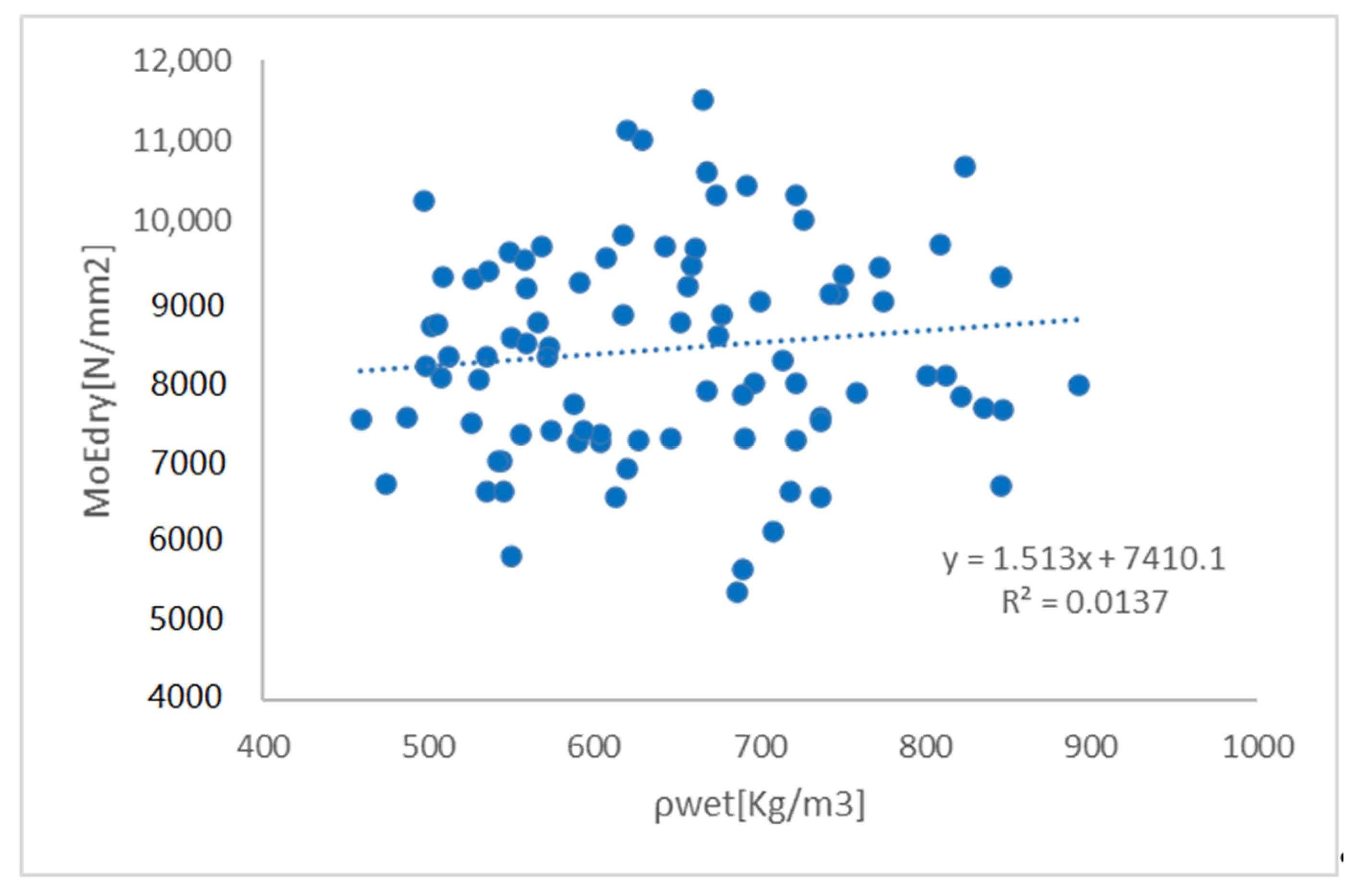
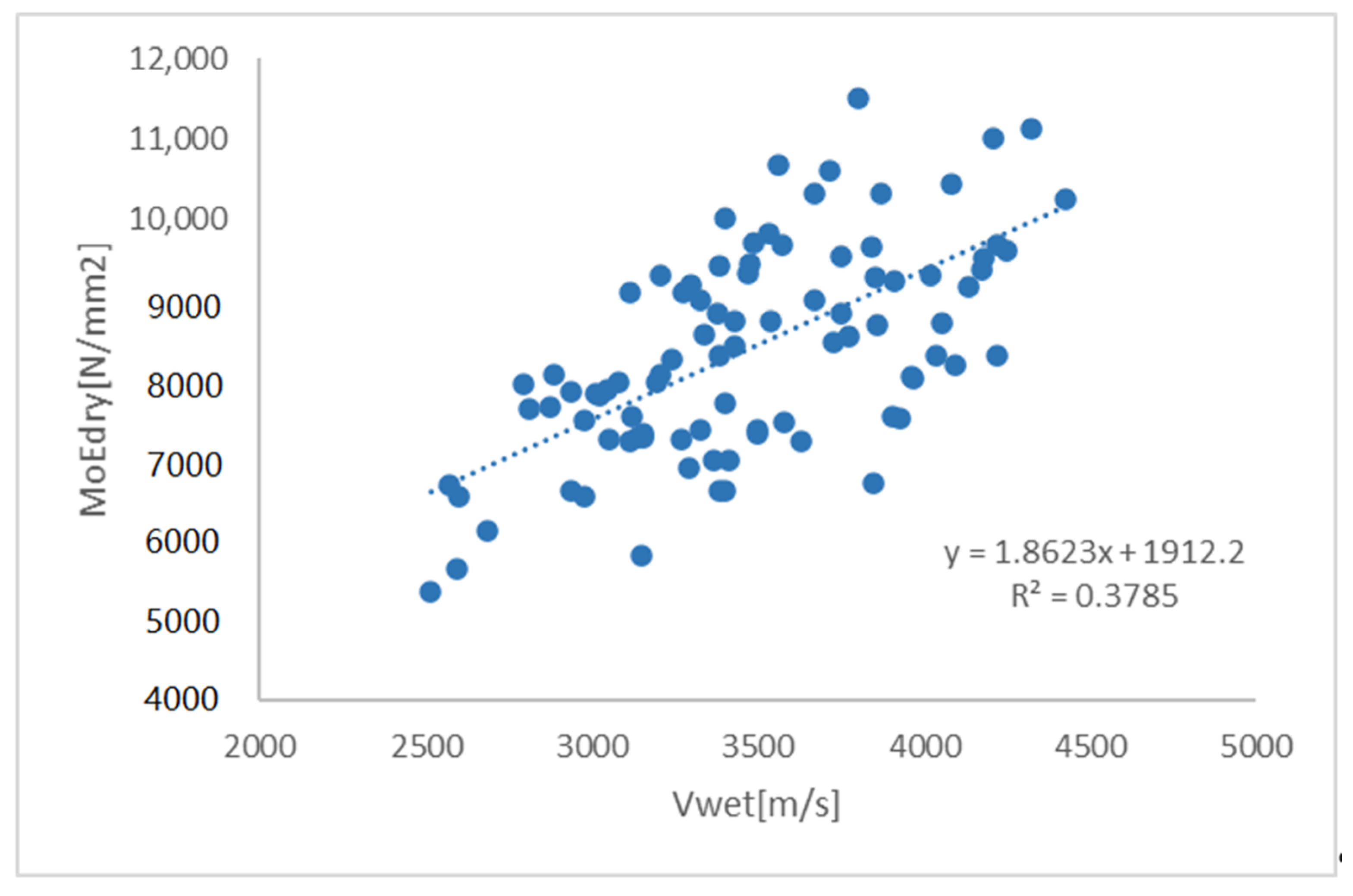
| Width [mm] | Thickness [mm] | Length [mm] |
|---|---|---|
| 106.0 ± 3.0 | 42.6 ± 1.4 | 2799 ± 1.6 |
| U [%] | m [Kg] | ρ [Kg/m3] | V [m/s] | MoEdyn [N/mm2] | |
|---|---|---|---|---|---|
| wet | 22.5 ± 5.0 | 8.2 ± 1.4 | 646.2 ± 105.8 | 3477 ± 451 | 7743 ± 1595 |
| dry | 11.4 ± 0.7 | 6.3 ± 0.5 | 495.5 ± 34.8 | 4106 ± 330 | 8388 ± 1366 |
| U [%] | MoEdyn [N/mm2] | |
|---|---|---|
| wet | 22.5 ± 5.0 | 7743 ± 1595 |
| dry | 11.4 ± 0.7 | 8388 ± 1366 |
Publisher’s Note: MDPI stays neutral with regard to jurisdictional claims in published maps and institutional affiliations. |
© 2021 by the author. Licensee MDPI, Basel, Switzerland. This article is an open access article distributed under the terms and conditions of the Creative Commons Attribution (CC BY) license (http://creativecommons.org/licenses/by/4.0/).
Share and Cite
Concu, G. Prediction of Maritime Pine Boards Modulus of Elasticity by Means of Sonic Testing on Green Timber. Appl. Sci. 2021, 11, 1748. https://doi.org/10.3390/app11041748
Concu G. Prediction of Maritime Pine Boards Modulus of Elasticity by Means of Sonic Testing on Green Timber. Applied Sciences. 2021; 11(4):1748. https://doi.org/10.3390/app11041748
Chicago/Turabian StyleConcu, Giovanna. 2021. "Prediction of Maritime Pine Boards Modulus of Elasticity by Means of Sonic Testing on Green Timber" Applied Sciences 11, no. 4: 1748. https://doi.org/10.3390/app11041748





